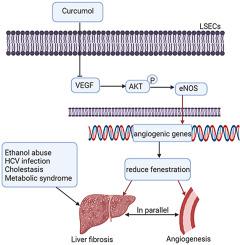Journal of Ethnopharmacology ( IF 4.8 ) Pub Date : 2021-08-04 , DOI: 10.1016/j.jep.2021.114480 Yang Zheng 1 , Jiaru Wang 2 , Tiejian Zhao 3 , Lei Wang 1 , Jiahui Wang 1

|
Ethnopharmacological relevance
Curcuma is a common Chinese herbal medicine that is used in the clinical treatment of chronic liver disease. Studies have found that curcumol is the main active ingredient of curcuma and has good hepatoprotective and anti-inflammatory effects. However, there are few reports on the molecular mechanism underlying the anti-liver fibrosis effect of curcumol.
Aim
To explore the effect of curcumol on liver angiogenesis, and to reveal the mechanism of curcumol against liver fibrosis.
Materials and methods
We used liver collagenase perfusion combined with Percoll density gradient sedimentation to separate primary liver sinusoidal endothelial cells, and then applied a leptin-activated cell pathological model. The cells were divided into four treatment groups as follows: blank group, model group, curcumol group, and solafini group. MTT was used to detect the cell proliferation rate in each group, and RT-PCR and western blotting were used to detect the expressions of VEGF, AKT, eNOS, CD31, and vWF. A fluorescent probe was used to detect NO expression, and scanning electron microscopy was used to observe changes in the cell fenestration structure. Angiogenesis assays were used to observe blood vessel formation in each group.
Results
The results of the MTT test found that the proliferation rate of each group was higher. The results of the molecular biology tests found that curcumol inhibited the activity of the VEGF/AKT/eNOS pathway, thereby increasing fenestration of sinusoidal endothelial cells and inhibiting liver angiogenesis. These differences were statistically significant compared with the model group.
Conclusions
Curcumol inhibits the activity of the VEGF/AKT/eNOS signaling pathway, regulates the structure of hepatic sinusoidal endothelial cells, and inhibits liver angiogenesis, which together may explain its anti-liver fibrosis mechanism.
中文翻译:

调控VEGF/AKT/eNOS信号通路调控肝血管生成探索姜黄素抗肝纤维化机制
民族药理学相关性
姜黄是临床常用的治疗慢性肝病的中草药。研究发现,姜黄素是姜黄的主要活性成分,具有良好的保肝抗炎作用。然而,关于姜黄素抗肝纤维化作用的分子机制的报道很少。
目标
探讨姜黄素对肝血管生成的影响,揭示姜黄素抗肝纤维化的作用机制。
材料和方法
我们采用肝胶原酶灌注联合Percoll密度梯度沉降分离原代肝窦内皮细胞,然后应用瘦素激活细胞病理模型。将细胞分为如下四个处理组:空白组、模型组、姜黄素组和索拉菲尼组。MTT法检测各组细胞增殖率,RT-PCR和western blotting检测VEGF、AKT、eNOS、CD31、vWF的表达。用荧光探针检测NO的表达,用扫描电镜观察细胞开窗结构的变化。血管生成试验用于观察每组的血管形成。
结果
MTT检测结果发现各组增殖率较高。分子生物学检测结果发现,姜黄素抑制VEGF/AKT/eNOS通路的活性,从而增加肝窦内皮细胞的开窗,抑制肝血管生成。与模型组相比,这些差异具有统计学意义。
结论
姜黄素抑制 VEGF/AKT/eNOS 信号通路的活性,调节肝窦内皮细胞的结构,抑制肝血管生成,这些可能共同解释其抗肝纤维化机制。































 京公网安备 11010802027423号
京公网安备 11010802027423号